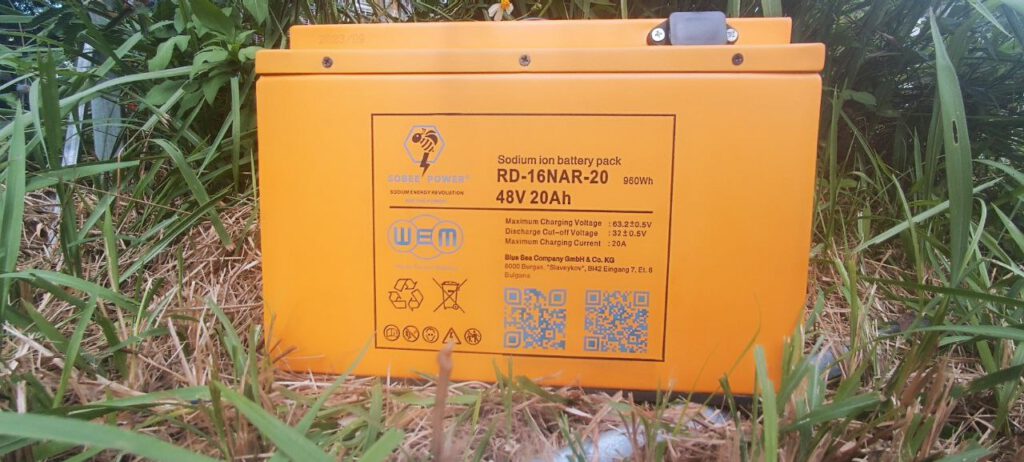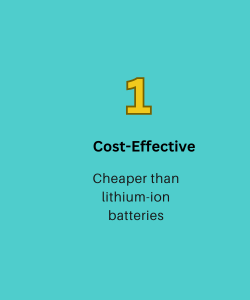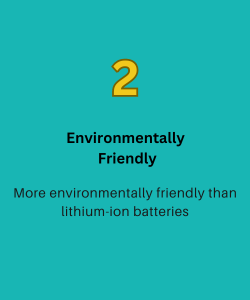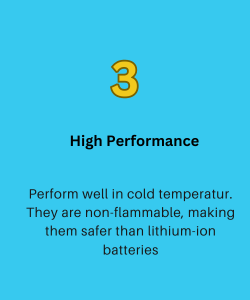
Sodium-Ion Batteries
We are excited to offer revolutionary sodium-ion batteries for electric cars, solar panels, wind turbines, and everyday life. Here are some reasons why we believe sodium-ion batteries are the future:

Sodium-ion batteries are cheaper than lithium-ion batteries, making them a more cost-effective option for energy storage. This means that electric cars and other electronic devices can be produced at a lower cost, making them more accessible to consumers.

Sodium-ion batteries are more environmentally friendly than lithium-ion batteries. They are made from sodium, which is abundant and readily available, unlike lithium, which requires mining and can be harmful to the environment.

Sodium-ion batteries have been shown to perform well in cold temperatures, making them a great option for electric cars and other devices that need to operate in harsh conditions. They are also non-flammable, making them safer than lithium-ion batteries.

Recent breakthroughs in sodium-ion battery technology have greatly extended their longevity, making them a promising option for powering electric vehicles and storing solar energy.
LiFePO4 batteries
LiFePO4 batteries offer a number of advantages compared to conventional lithium-ion batteries.
They hardly get hot and do not burn.
An important advantage is the cost saving, as they do not contain expensive heavy metals such as nickel. These metals are essential in the production of NMC cells, which are increasingly being displaced by LiFePO4 cells, which contain manganese and cobalt.

LiFePO4 cells are less prone to overheating, short circuits, and thermal failures, which improves their safety profile.

They have a longer life than conventional lithium-ion batteries because they are less prone to degradation.

LiFePO4 batteries offer a high discharge rate, making them ideal for high-power demand applications.

Because they do not contain toxic heavy metals, LiFePO4 batteries are more environmentally friendly and easier to recycle.

They are versatile and suitable for many applications, from electric vehicles to renewable energy storage.

LiFePO4 cells are more stable in terms of voltage and temperature, resulting in reliable performance.
At our battery and sunpower company, we are committed to providing innovative and sustainable solutions for energy storage. Our sodium-ion batteries are just one example of our commitment to a cleaner and more sustainable future. Contact us today to learn more about our products and services.
Comparison LiFePO4 and Sodium Battery
Sodium salt batteries and LiFePO4 batteries represent distinct battery technologies with varying attributes. To facilitate a comprehensive evaluation, here is a comparative analysis:
Chemistry:
- Sodium Salt Battery: Utilizes sodium ions for electron transport.
- LiFePO4 Battery: Employs lithium iron phosphate for electron transport.
Energy Density:
LiFePO4 batteries typically exhibit a superior energy density compared to sodium salt batteries, signifying their capacity to store more energy per unit weight.
Lifetime:
LiFePO4 batteries enjoy a marginally extended operational lifespan, capable of enduring a greater number of charge and discharge cycles than sodium salt batteries.
For context, sodium-sodium batteries maintain an operational capacity of 75%-90% after approximately 5000-7000 charging cycles, whereas LiFePO4 iron phosphate batteries retain similar performance levels after roughly 6000-8000 charge cycles.
Environmental Impact:
Sodium salt batteries are regarded as more ecologically sustainable due to their absence of lithium. Sodium, in the form of salt, is a widely abundant and less environmentally taxing element.
Conversely, LiFePO4 batteries contain lithium, the mining and production of which can carry environmental implications.
Applications:
Sodium salt batteries find frequent application in large-scale energy storage projects and grid stabilization endeavors.
In contrast, LiFePO4 batteries are prevalent in a myriad of applications, including portable electronics, electric vehicles, and solar energy systems.
The selection between these two battery types hinges upon the specific project requirements and the environmental considerations pertinent to the application.
